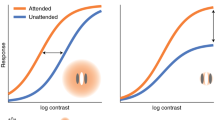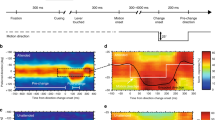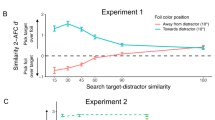Abstract
Covert attention, the selective processing of visual information in the absence of eye movements, improves behavioral performance. We found that attention, both exogenous (involuntary) and endogenous (voluntary), can affect performance by contrast or response gain changes, depending on the stimulus size and the relative size of the attention field. These two variables were manipulated in a cueing task while stimulus contrast was varied. We observed a change in behavioral performance consonant with a change in contrast gain for small stimuli paired with spatial uncertainty and a change in response gain for large stimuli presented at one location (no uncertainty) and surrounded by irrelevant flanking distracters. A complementary neuroimaging experiment revealed that observers' attention fields were wider with than without spatial uncertainty. Our results support important predictions of the normalization model of attention and reconcile previous, seemingly contradictory findings on the effects of visual attention.
This is a preview of subscription content, access via your institution
Access options
Subscribe to this journal
Receive 12 print issues and online access
$209.00 per year
only $17.42 per issue
Buy this article
- Purchase on Springer Link
- Instant access to full article PDF
Prices may be subject to local taxes which are calculated during checkout





Similar content being viewed by others
References
Reynolds, J.H. & Heeger, D.J. The normalization model of attention. Neuron 61, 168–185 (2009).
Reynolds, J.H. & Chelazzi, L. Attentional modulation of visual processing. Annu. Rev. Neurosci. 27, 611–647 (2004).
Carrasco, M. Covert attention increases contrast sensitivity: psychophysical, neurophysiological and neuroimaging studies. Prog. Brain Res. 154, 33–70 (2006).
Boynton, G.M. A framework for describing the effects of attention on visual responses. Vision Res. 49, 1129–1143 (2009).
Desimone, R. & Duncan, J. Neural mechanisms of selective visual attention. Annu. Rev. Neurosci. 18, 193–222 (1995).
McAdams, C.J. & Maunsell, J.H. Effects of attention on orientation-tuning functions of single neurons in macaque cortical area V4. J. Neurosci. 19, 431–441 (1999).
Pestilli, F. & Carrasco, M. Attention enhances contrast sensitivity at cued and impairs it at uncued locations. Vision Res. 45, 1867–1875 (2005).
Pestilli, F., Viera, G. & Carrasco, M. How do attention and adaptation affect contrast sensitivity? J. Vis. 7, 9 1–12 (2007).
Ling, S. & Carrasco, M. Sustained and transient covert attention enhance the signal via different contrast response functions. Vision Res. 46, 1210–1220 (2006).
Pestilli, F., Ling, S. & Carrasco, M. A population-coding model of attention's influence on contrast response: estimating neural effects from psychophysical data. Vision Res. 49, 1144–1153 (2009).
Morrone, M.C., Denti, V. & Spinelli, D. Color and luminance contrasts attract independent attention. Curr. Biol. 12, 1134–1137 (2002).
Morrone, M.C., Denti, V. & Spinelli, D. Different attentional resources modulate the gain mechanisms for color and luminance contrast. Vision Res. 44, 1389–1401 (2004).
Li, X., Lu, Z.L., Tjan, B.S., Dosher, B.A. & Chu, W. Blood oxygenation level–dependent contrast response functions identify mechanisms of covert attention in early visual areas. Proc. Natl. Acad. Sci. USA 105, 6202–6207 (2008).
Martínez-Trujillo, J. & Treue, S. Attentional modulation strength in cortical area MT depends on stimulus contrast. Neuron 35, 365–370 (2002).
Reynolds, J.H., Pasternak, T. & Desimone, R. Attention increases sensitivity of V4 neurons. Neuron 26, 703–714 (2000).
Buracas, G.T. & Boynton, G.M. The effect of spatial attention on contrast response functions in human visual cortex. J. Neurosci. 27, 93–97 (2007).
Williford, T. & Maunsell, J.H. Effects of spatial attention on contrast response functions in macaque area V4. J. Neurophysiol. 96, 40–54 (2006).
Huang, L. & Dobkins, K.R. Attentional effects on contrast discrimination in humans: evidence for both contrast gain and response gain. Vision Res. 45, 1201–1212 (2005).
Lee, J. & Maunsell, J.H. A normalization model of attentional modulation of single unit responses. PLoS ONE 4, e4651 (2009).
Reynolds, J.H., Chelazzi, L. & Desimone, R. Competitive mechanisms subserve attention in macaque areas V2 and V4. J. Neurosci. 19, 1736–1753 (1999).
Datta, R. & DeYoe, E.A. I know where you are secretly attending! The topography of human visual attention revealed with fMRI. Vision Res. 49, 1037–1044 (2009).
Eriksen, C.W. & St James, J.D. Visual attention within and around the field of focal attention: a zoom lens model. Percept. Psychophys. 40, 225–240 (1986).
Müller, N.G., Bartelt, O.A., Donner, T.H., Villringer, A. & Brandt, S.A. A physiological correlate of the “Zoom Lens” of visual attention. J. Neurosci. 23, 3561–3565 (2003).
Castiello, U. & Umilta, C. Size of the attentional focus and efficiency of processing. Acta Psychol. (Amst.) 73, 195–209 (1990).
Ling, S. & Carrasco, M. When sustained attention impairs perception. Nat. Neurosci. 9, 1243–1245 (2006).
Lu, Z.L. & Dosher, B.A. Spatial attention: different mechanisms for central and peripheral temporal precues? J. Exp. Psychol. Hum. Percept. Perform. 26, 1534–1548 (2000).
Nakayama, K. & Mackeben, M. Sustained and transient components of focal visual attention. Vision Res. 29, 1631–1647 (1989).
Liu, T., Pestilli, F. & Carrasco, M. Transient attention enhances perceptual performance and fMRI response in human visual cortex. Neuron 45, 469–477 (2005).
Giordano, A.M., McElree, B. & Carrasco, M. On the automaticity and flexibility of covert attention: a speed-accuracy trade-off analysis. J. Vis. 9, 30 31–10 (2009).
Yeshurun, Y., Montagna, B. & Carrasco, M. On the flexibility of sustained attention and its effects on a texture segmentation task. Vision Res. 48, 80–95 (2008).
Jonides, J. & Irwin, D.E. Capturing attention. Cognition 10, 145–150 (1981).
Sclar, G., Maunsell, J.H. & Lennie, P. Coding of image contrast in central visual pathways of the macaque monkey. Vision Res. 30, 1–10 (1990).
Kastner, S., Pinsk, M.A., De Weerd, P., Desimone, R. & Ungerleider, L.G. Increased activity in human visual cortex during directed attention in the absence of visual stimulation. Neuron 22, 751–761 (1999).
Gandhi, S.P., Heeger, D.J. & Boynton, G.M. Spatial attention affects brain activity in human primary visual cortex. Proc. Natl. Acad. Sci. USA 96, 3314–3319 (1999).
Tootell, R.B. et al. The retinotopy of visual spatial attention. Neuron 21, 1409–1422 (1998).
Brefczynski, J.A. & DeYoe, E.A. A physiological correlate of the 'spotlight' of visual attention. Nat. Neurosci. 2, 370–374 (1999).
Somers, D.C., Dale, A.M., Seiffert, A.E. & Tootell, R.B. Functional MRI reveals spatially specific attentional modulation in human primary visual cortex. Proc. Natl. Acad. Sci. USA 96, 1663–1668 (1999).
Jazayeri, M. & Movshon, J.A. Optimal representation of sensory information by neural populations. Nat. Neurosci. 9, 690–696 (2006).
Katkov, M., Tsodyks, M. & Sagi, D. Inverse modeling of human contrast response. Vision Res. 47, 2855–2867 (2007).
Dean, A.F. The variability of discharge of simple cells in the cat striate cortex. Exp. Brain Res. 44, 437–440 (1981).
Carandini, M. Amplification of trial-to-trial response variability by neurons in visual cortex. PLoS Biol. 2, e264 (2004).
Heeger, D.J. & Ress, D. What does fMRI tell us about neuronal activity? Nat. Rev. Neurosci. 3, 142–151 (2002).
Logothetis, N.K. & Wandell, B.A. Interpreting the BOLD signal. Annu. Rev. Physiol. 66, 735–769 (2004).
Bartels, A., Logothetis, N.K. & Moutoussis, K. fMRI and its interpretations: an illustration on directional selectivity in area V5/MT. Trends Neurosci. 31, 444–453 (2008).
Hernandez, M., Costa, A. & Humphreys, G.W. The size of an attentional window affects working memory guidance. Atten. Percept. Psychophys. 72, 963–972.
Belopolsky, A.V., Zwaan, L., Theeuwes, J. & Kramer, A.F. The size of an attentional window modulates attentional capture by color singletons. Psychon. Bull. Rev. 14, 934–938 (2007).
Liu, T., Stevens, S.T. & Carrasco, M. Comparing the time course and efficacy of spatial and feature-based attention. Vision Res. 47, 108–113 (2007).
Sperling, G.D.B.A. (ed.) Handbook of Perception and Human Performance, 1–65 (John Wiley & Sons, 1986).
Wandell, B.A., Dumoulin, S.O. & Brewer, A.A. Visual field maps in human cortex. Neuron 56, 366–383 (2007).
Donner, T.H., Sagi, D., Bonneh, Y.S. & Heeger, D.J. Opposite neural signatures of motion-induced blindness in human dorsal and ventral visual cortex. J. Neurosci. 28, 10298–10310 (2008).
Acknowledgements
We thank Mike Landy and members of the Carrasco and Heeger laboratories for their helpful comments. The psychophysical experiments were presented at the Annual Meeting of the Vision Science Society (2009) and the European Conference on Visual Perception (2009). This work was supported by US National Institutes of Health grants R01-EY019693 (D.J.H. and M.C.), R01-MH06980 (D.J.H.) and R01-EY016200 (M.C.).
Author information
Authors and Affiliations
Contributions
K.H. programmed, conducted and analyzed the experiments and co-wrote the manuscript. L.M.-K. conducted and analyzed the psychophysics experiments and assisted in conducting and programming the fMRI experiment. M.C. and D.J.H. conceived and supervised the project and co-wrote the manuscript.
Corresponding author
Ethics declarations
Competing interests
The authors declare no competing financial interests.
Supplementary information
Supplementary Text and Figures
Supplementary Figures 1–3 and Supplementary Tables 1 and 2 (PDF 403 kb)
Rights and permissions
About this article
Cite this article
Herrmann, K., Montaser-Kouhsari, L., Carrasco, M. et al. When size matters: attention affects performance by contrast or response gain. Nat Neurosci 13, 1554–1559 (2010). https://doi.org/10.1038/nn.2669
Received:
Accepted:
Published:
Issue Date:
DOI: https://doi.org/10.1038/nn.2669
This article is cited by
-
Laminar compartmentalization of attention modulation in area V4 aligns with the demands of visual processing hierarchy in the cortex
Scientific Reports (2023)
-
Dissociable roles of human frontal eye fields and early visual cortex in presaccadic attention
Nature Communications (2023)
-
Cross-modal orienting of exogenous attention results in visual-cortical facilitation, not suppression
Scientific Reports (2021)
-
Attentional focus modulates automatic finger-tapping movements
Scientific Reports (2021)
-
A dynamic normalization model of temporal attention
Nature Human Behaviour (2021)



